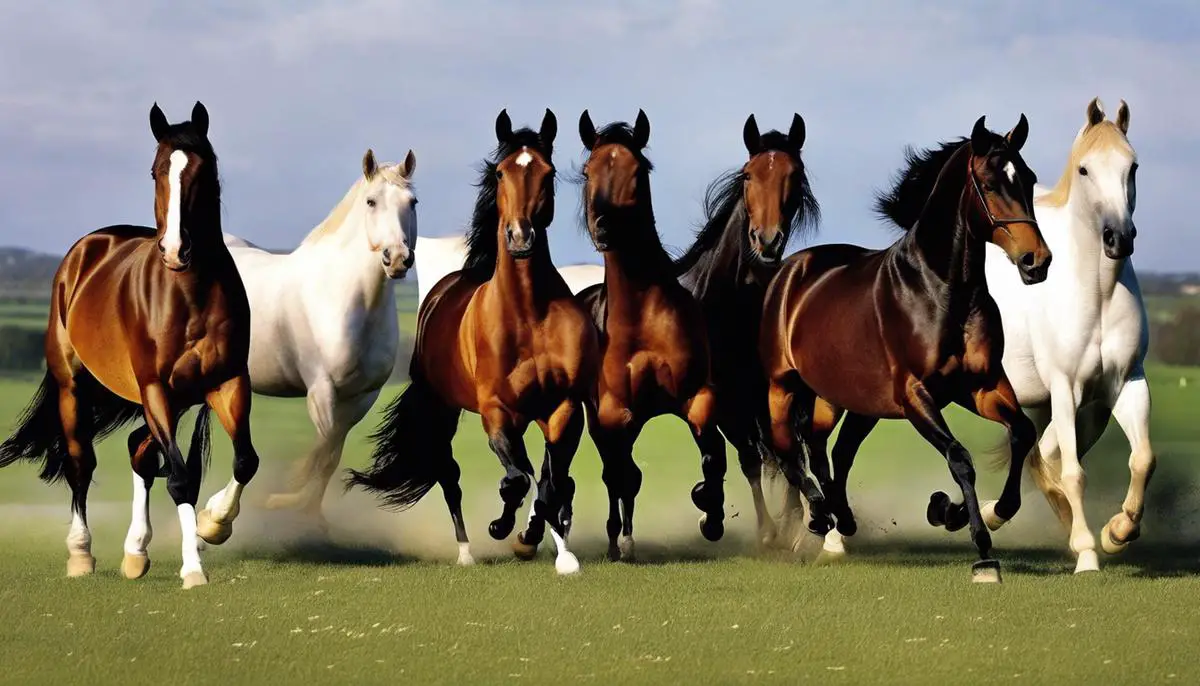In the fascinating world of equestrian sports, one type of horse stands out above the rest—the Warmblood. From their intriguing history and origin to the distinguished feats they have accomplished in various equestrian competitions, Warmbloods hold a special place in the hearts of horse enthusiasts and professionals alike. Renowned for their physicality, temperament, and exceptional skills in show jumping, dressage, and eventing, these horses have made significant contributions to the equestrian sports world. Understanding their story goes a long way in grasping why they are so highly valued. This exploration begins with an in-depth journey into the history of Warmbloods, highlighting their evolution, introduction into equestrian sports, and the unique traits that define them.
Table of Contents (Horspedia)
History and Origin of Warmbloods
The Noble Journey: Unraveling the History and Origin of Warmbloods
There’s a captivating charm and allure to warmblood horses, an undeniable magnetism that has drawn enthusiasts and hobbyist all across the globe. More than a hobby, the love for warmbloods can shape and define a lifetime. But ever wondered how these majestic animals came into the picture? Let’s take a stride back in time and unravel warmbloods’ history and origin.
Warmbloods, contrary to their name, aren’t recognized as a breed but are a group of middle-weight horses that originated in Europe. A unique wonder, these magnates of equine universe have an exotic blend of drafted horses’ strength and the speed and finesse of hotbloods like Arabian horses or Thoroughbreds.
The story of warmbloods is as old as the Middle Ages in Europe. During this time, European farmers needed powerful and versatile horses capable of accomplishing various tasks. They bred heavy, strong draft horses with nimble and hotter blood – often Arabian or Thoroughbreds – for a more balanced, multi-purpose horse.
The ‘breeding direction’ varied by region in Europe, resulting in the development of several distinct types of warmbloods. The Hanoverians became a staple in Germany, while the Dutch shaped the Dutch Warmblood, and France saw the birth of the Selle Francais. Some of these breeds trace their lineage as far back as the 16th and 17th centuries, returning us to a period where horses were an integral part of daily life.
These horses, brought into existence by necessity, soon found a fan following amidst the Royals who saw their potential as elite war steeds and carriage horses. The warmbloods’ elegance, stalwart strength, and noble carriage made them perfect partners, valuable in warfare, transport, and later, sporting arenas.
Come the 20th century, the advent of mechanization lessened the dependence on horses as work animals. However, that didn’t diminish the love for warmbloods. Their reputation saw a shift from workhorses to iconic stars of equestrian sports. Breeders focused on refining and evolving these breeds for modern equestrian athletics such as jumping, dressage, and eventing.
Today, warmbloods’ performance in equestrian events is testament to centuries of meticulous breeding. Numerous horses like the Dutch Warmblood Totilas have made their mark globally, showcasing the sublime blend of agility, power, and grace that defines a warmblood.
The history and origin of warmbloods is a fascinating journey that mirrors humanity’s evolution and its relationship with equine companions. It’s a tale of creating beauty from necessity, of crafting an animal companion so versatile, robust, and elegant that it continues to captivate horse lovers all over the world today.
So every time you witness a warmblood in action, remember that you’re not just watching a horse, you’re witnessing centuries of passionate breeding, cultural history, and the love for equine excellence. In the world of equestrian sports, warmbloods aren’t merely participants; they’re heritage trotting on hooves.

Characteristics of Warmbloods in Equestrian Sports
Broadening the Scope: Warmbloods in Equestrian Sports
While the historical importance and characteristics of Warmbloods are undeniably captivating, the role Warmbloods play in contemporary equestrian sports brings an even further edge of excitement. With a legacy shaped by their endurance, agility, and power, these versatile horses have proved over time to be a significant asset for those interested in participating in these sports.
Let’s delve into what makes Warmbloods the giants of Equestrian sports!
Absolute Powerhouse Athletes
Warmbloods excel in disciplines that require strength, agility, quick thinking, and finesse – traits these horses certainly have in abundance! Their powerfully muscular bodies in combination with their innate grace make them perfect competitors in a variety of equestrian sports. From Dressage, where the Warmblood’s elegance & ballet-like footwork shines, to Show Jumping, where their strength and agility come to the fore, these horses consistently outperform in competitions worldwide.
Warmbloods have also been known to dominate Eventing, a challenging equestrian sport that is the ultimate test of a horse’s versatility. This competitive sphere uniquely combines dressage, cross-country, and show jumping, allowing the Warmblood’s multipurpose propensity to truly stand out.
Physiology That Complements Performance
When it comes to equestrian sports, Warmblood’s physical attributes are a huge boon. They possess a larger-than-average build, a deep chest, and powerful hindquarters ideal for driving forward motion. They also tend to have a high-set neck, contributing positively to their balance and poise, both of which are highly beneficial, especially in disciplines like Dressage.
Moreover, their strikings size—somewhere between the petite Arabians and the heavy draft horses—confers upon them a unique blend of speed, agility, and endurance, making Warmbloods a force to be reckoned with in the arena.
A Temperament Designed for Equestrian Sports
Apart from their physical prowess, Warmbloods are also well-loved for their temperament that harmonizes perfectly with the demands of equestrian sports. ‘Warmblooded’ typically signifies a balanced and adaptable temperament, and these equine athletes don’t disappoint. Known for their alert, intelligent, yet calm demeanor, Warmbloods subtly exude a keen sense of confidence. Their inherent willingness to please and ability to form strong bonds with their riders undoubtedly set them a cut above the rest in the show ring.
Equally Striking Off the Competition Grounds
While Warmbloods are exceptional as competition horses, their accomodating nature extends beyond the arena. Today, many riders, from novices to experts, choose Warmbloods not only for the equestrian sports glory but also for recreational riding, thereby ensuring these stunning beasts a central place in the hearts of many across the globe.
Whether it’s their formidable presence in the competition ring, their unique physical attributes that lend to performance, or their intelligent and kind-hearted temperament that wins hearts, Warmbloods undeniably stand out in the equestrian world. As long as there’s a love for horses, and the enduring challenge and beauty of equestrian sports, Warmbloods will proudly continue to hold their reins in this thrilling domain. With each powerful stride they take, Warmbloods will forever embody the breathtaking, transformative spirit of equestrianism. Surely, they’re not just part of the sport; they are the sport.
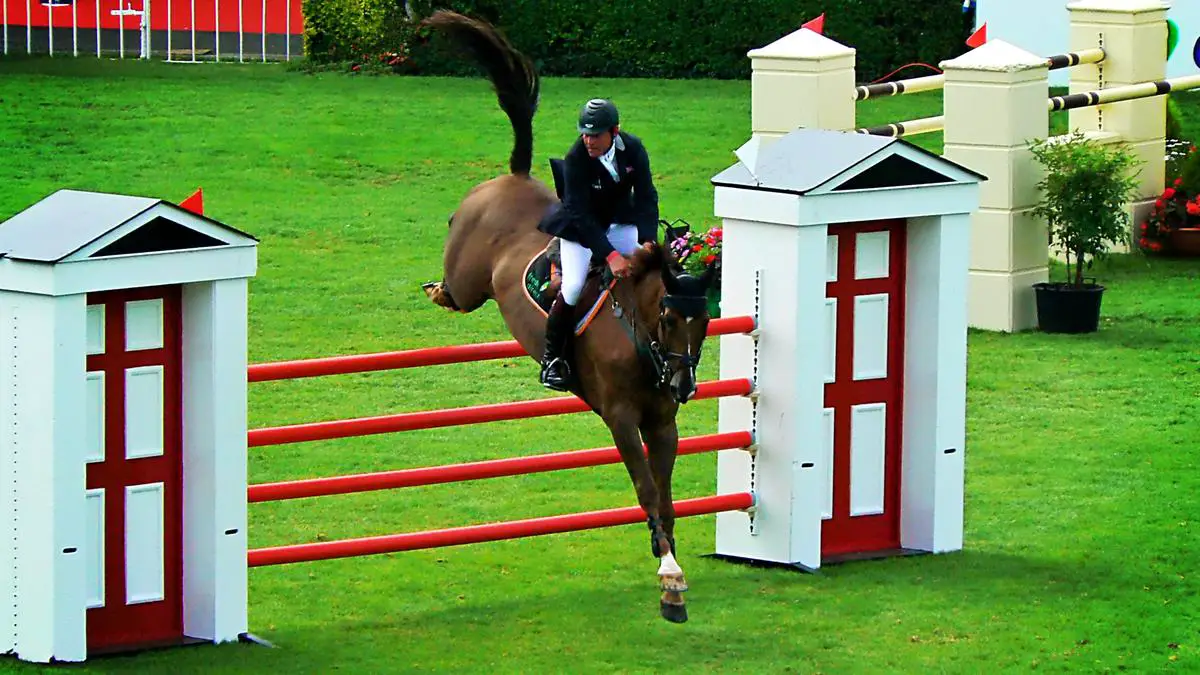
Photo by kmitchhodge on Unsplash
Breeding and Training Warmbloods for Equestrian Sports
Stepping into the fascinating world of Warmblood breeding and training for equestrian sports is a truly rewarding journey that unveils the masterful art and science behind these stunning athletes. Warmbloods, loved and admired for their great strength, versatility, and admirable temperament, are the stars of the equestrian world. But how are these magnificent creatures bred and trained for this elite world of horse sports?
Breeding Warmbloods is a careful equation balancing genetics, health, conformation, and, of course, the temperament. A key process followed by breeders is “Selection,” undertaken by breeding companies and associations that ensure high quality in each generation. The aim is to continually improve and enhance breed characteristics.
Typically, breeders begin with mares of high pedigree, possessing the traits crucial in an equestrian sport horse—strength, intelligence, and athleticism. Stallions are chosen based on performance, lineage, and their genetic compatibility with the mare. Rigorous health checks are undertaken, followed by the pure magic of creating a harmonious blend of genetic strength, temperament, and athleticism.
The resultant foals are groomed from a young age, with the aim of nurturing their innate abilities while ensuring good health and temperament. Warmbloods are a late-maturing breed, so their training typically begins in earnest at around three years of age, allowing them to develop both physically and mentally.
And the right training is just as important as good breeding in the creation of equestrian sport Warmbloods. Patience and consistency are key here. Young Warmbloods are gradually introduced to ground work basics—leading, loading, and grooming—and then slowly advanced to lunge work, bridle and saddle wearing, and eventually, carrying a rider.
Warmbloods’ intrinsic trainability and willing nature make them incredible learners. Training techniques used for Warmbloods in equestrian sports focuses on enhancing their natural capabilities—power, grace, and agility—while fostering their calm, intelligent nature. Techniques like dressage, designed to develop a horse’s obedience, flexibility, and balance, are perfectly suited to these breeds and lay the groundwork for success in various sports.
Showjumping training centers around building the horse’s strength and accuracy over fences, combining both flatwork and jumping exercises. For eventing, they are trained in the three disciplines of dressage, cross-country, and show jumping. The diversity and adaptability of Warmbloods make them apt for this challenging discipline.
One critical aspect of training is ensuring the Warmblood’s happiness and wellbeing. Their intelligence and sensitivity make them susceptible to boredom and stress, necessitating varied, enjoyable training programs and a supportive, understanding handler.
However, diligent breeding and training are not the sole factors contributing to their impressive performances in equestrian sports. After all, these are highly sociable, sensitive animals that form deep bonds with their riders. The secret recipe hence consists of equal parts breeding, training, and the symbiotic relationship between the Warmblood and their human partner, creating an unmatchable duo, one that weaves stories of spectacular sport and heartfelt companionship.
Breeding, training, partnership. Through this dynamic trinity, the splendid Warmblood emerges—a majestic equestrian sport athlete, a testament to the beautiful union of science, art, and the tender, enduring bond between horse and human. Therein lies the secret of the Warmblood’s success, and the reason for their steadfast place in the hearts of equestrians worldwide.
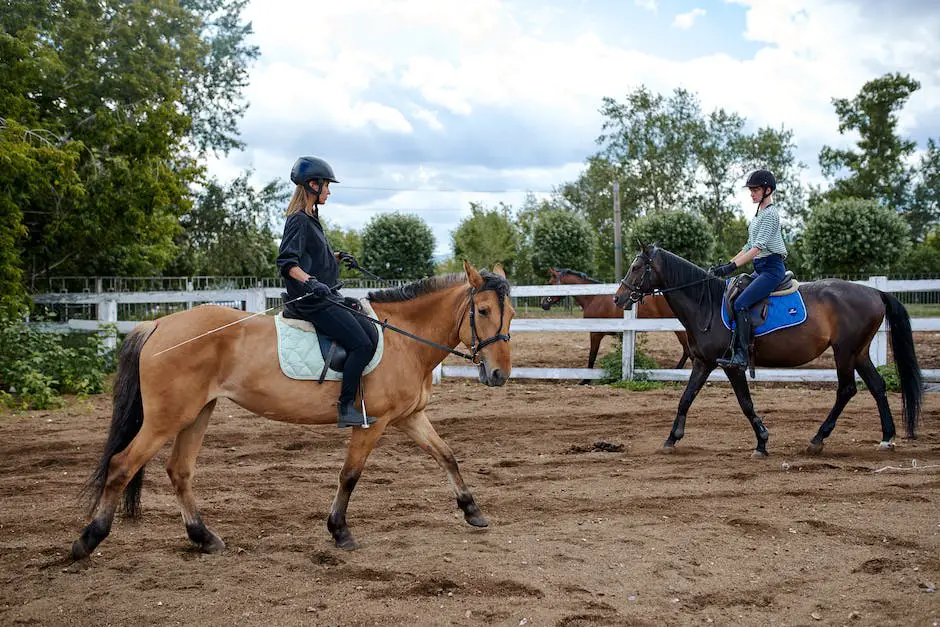
Maintenance and Care of Warmbloods
Now that we have covered the significant aspects pertinent to Warmbloods including a historical overview, performance attributes, popularity among enthusiasts, and in-depth insights into breeding and training, it is essential to delve into the realms of daily maintenance and care of these charming and superbly athletic creatures.
Warmbloods, like any horse breed, require regular attention to maintain good health, but due to their high-performance characteristics and intrinsic value, the significance of daily care cannot be overstated. The daily maintenance primarily involves feeding, grooming, exercise, and health check-ups.
Proper nutrition is fundamental to the well-being of Warmbloods. Premium quality hay or grass forms the bulk of their diet, supplemented by grains, vitamins, minerals, and fresh water to replenish their needs. The feed quantity and components are generally tailored based on the horse’s age, condition, and level of activity. Feeding should be consistent and broken down into small meals throughout the day to mimic their natural grazing habits and prevent digestive issues.
Grooming forms another integral part of daily care and serves multiple purposes. A thorough grooming includes brushing to keep their coat healthy and shining, cleaning out hooves to prevent infections, checking for any skin issues, and regular baths. Grooming is also an opportunity to check for signs of illnesses or injuries, and promotes bonding between the horse and its handler.
Physical exercise is not only essential for a Warmblood’s health but also to maintain their supreme athletic capabilities. Exercise can range from light riding, lunging, turnout in a safe paddock, or more intensive sessions if they are in active training for competition. Mental stimulation is equally crucial, and the inclusion of training variations, toys, or interaction with other horses can contribute significantly to their overall contentment.
In terms of health maintenance, daily observations are critical to detecting early signs of illness or discomfort, and regular vet check-ups are indispensable. Dental and hoof care also play a significant role, demanding scheduled appointments with a professional farrier and equine dentist to ensure optimal health.
Heat, ventilation and cleanliness of the horse’s living quarters is paramount to prevent respiratory issues and other illnesses. It is essential to muck out stalls daily, ensure proper ventilation, provide shelter from adverse weather conditions, and maintain a safe and comforting environment for the Warmblood to relax after a day of activity.
Caring for a Warmblood is indeed a commitment that demands time, energy, and a comprehensive understanding of their needs. But the rewards, be it in the form of a successful partnership in equestrian sports or just a strong personal bond forged with these magnificent equine wonders, are undoubtedly worth every bit of effort. They serve as a testament to the adage that what one reaps truly reflects what has been sown. It’s in this meticulous care and nurturing that Warmbloods unfurl their irresistible charm and exceptional capabilities, continuing to enchant their human companions throughout their life trails.
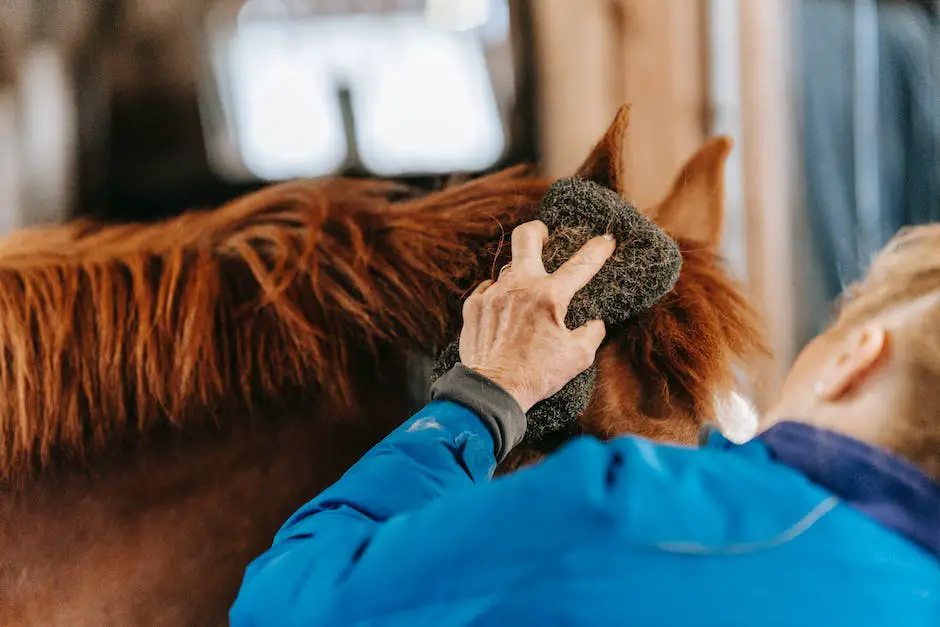
Success Stories of Warmbloods in Equestrian Sports
Continuing from the extensive previous coverage on warmbloods, let’s turn our focus towards the topic of notable warmbloods that have made their mark in equestrian sports.
Warmbloods are prevalent across a wide variety of renowned equestrian sports, such as dressage, showjumping, and eventing. They are distinguished not simply by their physical prowess or agility but by the shared bond and understanding between horse and rider, which is significantly nurtured by these breeds.
First out of the gate is Totilas, an elegant Dutch Warmblood that has set the bar high for dressage. This gorgeous creature, paired with rider Edward Gal, scorched records by achieving the first-ever score above 90 in Grand Prix Test. Totilas’ powerful movement, strength, and precision in performing complex maneuvers set a new benchmark in dressage.
Handlers and riders of showjumping will recall Milton, a gray Holsteiner gelding, as a legend in his event. Owned by the Hales family and ridden by John Whitaker, Milton had an exceptional career with numerous high-profile victories, including consecutive wins at the Horse of the Year Show and European Championships.
Eventing drew attention to the Thoroughbred/Westphalian cross, Charisma, ridden by Mark Todd from New Zealand. Charisma won back-to-back individual gold medals in the 1984 and 1988 Olympic Games, showing a balanced blend of jumping, dressage, and cross-country skills essential for eventing.
Another standout is Salinero, another Dutch Warmblood, expertly ridden by Anky Van Grunsven, which dominated the dressage world during his time. Winning two gold medals in the Olympic Games and two World Equestrian Games golds is proof of impeccable harmony between rider and horse.
For all the Royal enthusiasts out there, a special mention must go to the British-bred Hanoverian, Valegro, ridden by Charlotte Dujardin. This team took the equestrian world by storm, breaking world records in all three Grand Prix levels and securing multiple Olympic, European, and World Champion titles. Valegro’s powerful performances are a shining example of the grace and versatility inherent in warmblood breeds.
Decades of keen breeding, diligent training, and nurturing partnerships have led these iconic warmblood steeds to achieve unparalleled heights in the world of equestrian sports. Their unforgettable performances on the global stage have greatly enriched the tapestry of the warmblood breed narrative. The enduring love and significance of these equestrian marvels radiate through centuries, speaking volumes about the human-horse bond that transcends competitive sport.
The care bestowed upon warmbloods, from their daily maintenance to tailored training programs, as well as the understanding and empathy from their riders, shapes their transformation from impressive looking creatures to unforgettable equestrian legends. In honoring these prestigious warmbloods, we also appreciate every unsung hero who contributed their bit in sculpting these magnificent horse and rider partnerships.
May we continue to witness fantastic warmbloods galloping towards glory in the exciting world of equestrian sports for many more years to come.
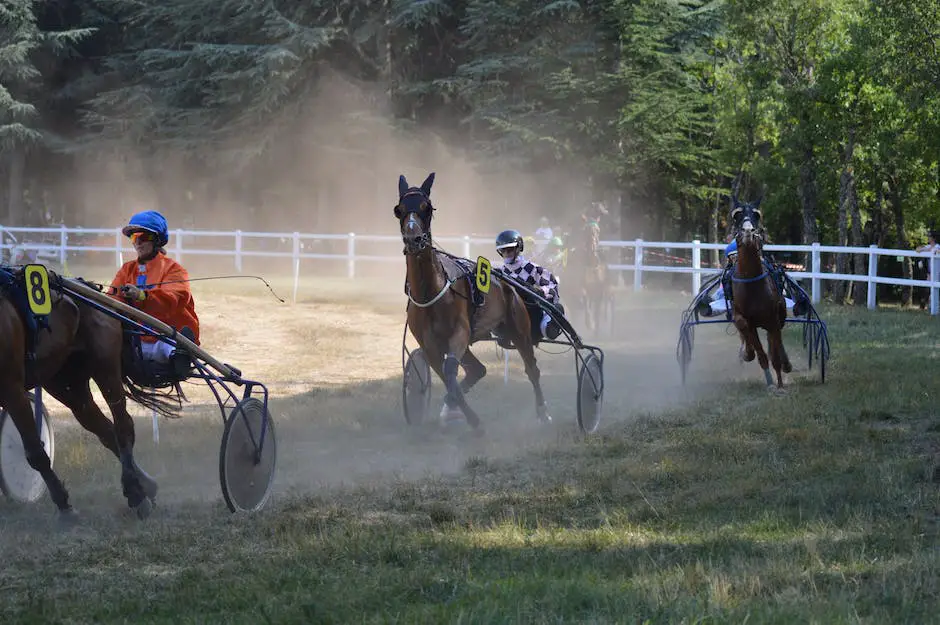
Above all, the journey of Warmbloods in equestrian sports remains filled with awe-inspiring triumphs and endless potential. The winning legacy they have crafted over time continues to inspire new generations of equestrian enthusiasts. Unveiling this timeline of Warmbloods’ success stories uncovers the measure of their contribution to their beloved field. These stories, combining aspects of breeding, training, and overcoming challenges, provide a comprehensive overview of their remarkable journey. The quintessential image of Warmbloods—graceful, powerful, and dedicated—remains a testament to the tireless efforts invested in breeding and training, keeping these noble beasts in prime condition. They stand as a symbol, manifesting the spirit of determination, endurance, and unparalleled excellence synonymous with equestrian sports.
